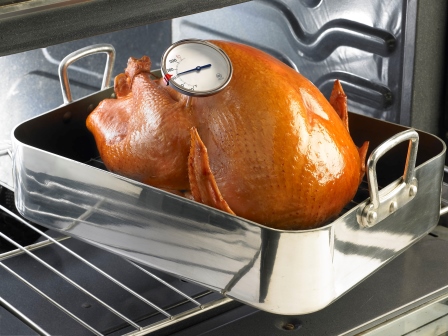Every December since I was a little girl I have watched the movie White Christmas with my mom so naturally, much of my favorite holiday music is from Bing Crosby.
As I was coordinating Christmas dinner with my mom and sister-in-law (who also happens to be a dietitian), I was listening to holiday music. On came one of Bing’s songs ‘Round and Round the Christmas Tree.’ Just as we were discussing my favorite holiday foods, Bing started singing of turkey and dressing. What a way to inspire a blog and an appetite?

Although it is now the 26th of December and many are experiencing that day-after-Christmas lull, turkey, dressing, mashed potatoes, green bean casserole and other traditional holiday foods remain in many Tupperware containers and refrigerators across the nation ready to be eaten as leftovers.
Before you start noshing on dinner from your doggy bag, make sure you follow these 5 precautions to ensure that leftover food won’t leave you feeling sick.
1. Make sure your food was originally cooked to a safe temperature. If it wasn’t, fewer bacteria were killed and there will be a greater risk for contamination for your food.- Red meats should be cooked to a minimum of 145°F
- Ground meats should be cooked to a minimum of 160°F
- Poultry should be cooked to a minimum of 165 °F
2. Keep your food out of the Temperature Danger Zone.
- Bacteria grow at a rapid rate in between 40°F and 140 °F. This temperature range is dubbed the “Temperature Danger Zone.” At the top of this zone, from 140 °F to 70°F, is when bacteria grow the fastest, making it important you cool food relatively quickly.
- If you have a dense food, such as hot turkey, that will take longer to cool, you can chill it in a cold water/ice bath or slice it into smaller pieces before packaging and putting into the refrigerator so it can cool more quickly.
- Separate leftover soup into multiple shallow containers to speed up cooling.
- Food should be refrigerated below 40°F or be frozen in covered containers.
3. Don’t leave food out for over two hours starting from the time it stops cooking.
Although you most likely would have rather taken a nap than put your leftover food away, you only have a two hour time frame from the time you took food out of the oven, off of the stove, or out of the refrigerator before certain foods could have grown enough bacteria or toxins from bacteria to make you sick and ruin your day. So if you have food that was left out at room temperature for more than 2 hours it should be discarded, because even if you reheat the food properly and kill the bacteria, the toxins some bacteria produced would remain present on the food and have the potential to lead to food poisoning.
4. Reheat your food properly.
Food should be brought up to 165°F, checking with a food thermometer, or if a liquid, such as a gravy or soup, bring it to a rolling boil. Covering the food while heating allows for the item to be evenly heated and also helps to retain moist heat which can further kill any potential bacteria. Stirring the item midway through cooking and allowing the food to ‘stand’ also promotes even heating.
5. Store food for the appropriate amount of time.
If stored in a refrigerator, most leftovers can be kept 3-4 days. If frozen, food can be kept up to 6 months depending on the type of food. Check out foodsafety.gov for precise recommended storage times of food.
What are your favorite ways to enjoy leftovers?
References:
- Handle Leftovers with Care. United States Department of Health and Human Services. Accessed December 213. http://www.foodsafety.gov/blog/leftovers.html
- Leftovers and Food Safety. Food Safety and Inspection Service. United States Department of Agriculture. Accessed December 2013. http://www.fsis.usda.gov/wps/portal/fsis/topics/food-safety-education/get-answers/food-safety-fact-sheets/safe-food-handling/leftovers-and-food-safety
- Storage Times for the Refrigerator and Freezer. United States Department of Health and Human Services. Accessed December 213. http://www.foodsafety.gov/keep/charts/storagetimes.html
Photo Credit:
USDAgov via photopin cc




